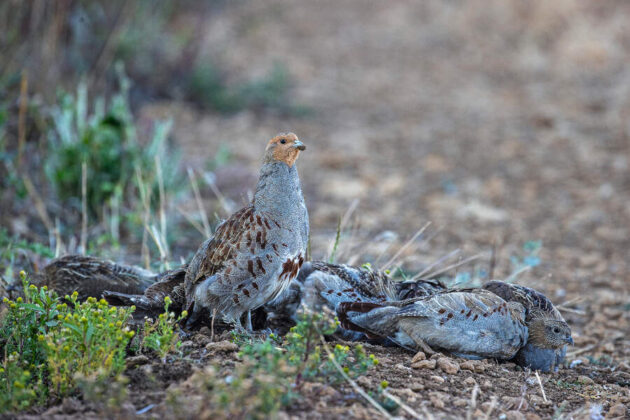Now open for 2025 entries, the Purdey Awards recognise the outstanding game and habitat conservation work carried out by shoots across the UK
For more information, visit Purdey Awards. The closing date for entries is 30 May 2025.
How to enter the Purdey Awards
- Established in 1999 and judged by an exceptional panel of engaged, experienced and enthusiastic conservationists and fieldsportsmen and women, the Purdey Awards are a benchmark for shooting and conservation.
- The 13 judges, led by chairman the Duke of Wellington, include Tim Furbank of Oakbank Game & Conservation, rural property expert Jonathan Kennedy and Editor of The Field Alexandra Henton.
- Each shortlisted entry receives a visit from members of the judging panel, who then award the coveted gold, silver, bronze and highly commended awards as well as the new outstanding individual award and a GWCT shoot visit.
Why you should considering entering
Never has it been more important to demonstrate the vital link between good shooting practice and its conservation benefits. And putting your shoot forward, or nominating one you know of, is the best way to help.

Polllinators such as butterflies are another key beneficiary of the habitat improvements made by shoots
A proud moment
One of the proudest moments of my career with the GWCT’s advisory service was when my friends and clients Ian and Claire Smith of Nether Hale in Kent came first in the Purdey Awards for Game & Conservation in 2003. Four years earlier, with just 350 acres to play with and a tight squeeze in the market for their main crop, the humble cauliflower, they had decided to stop growing them. Instead they would farm in a more diverse and conservation-friendly way, and do whatever they could to rescue a grey partridge population on the brink.
Spectacular results
The results were spectacular, with the pair count going from three in spring 2000 to 25 and rising by 2003. There were parallel increases in many other farmland birds, and hare populations increased by leaps and bounds too. The extra farm habitat, plus additions such as beetle banks and winter bird seed mixes, was also key to an ever-more successful small family shoot, providing a great environment for their released redlegs.
Speaking to Ian Smith recently I asked him what winning a Purdey Award meant. “At the time it was an enormous morale boost after a very tough period, and the certificate is still on display in pride of place in the dining room,” he replied. “It also gave us confidence in our conservation efforts, which still continue today. With ever-growing pressure from protected predators, the greys have gone full circle but we still have lots of farmland birds such as corn buntings and tree sparrows. The pollinators are a joy too, from bumble bees to small blue butterflies that recolonised after we planted kidney vetch for them.”
This story of enhanced confidence is one that I discover on a regular basis when speaking to other Purdey entrants around the country. Time and again I hear words along the lines of “We really benefited from the knowledge of the judges who visited us.” There is also another thread running through the Purdey Awards: success breeds success. They exist to celebrate the link between game shooting and conservation, and to reward those who have done it well. Year after year, entrants cite knowing about previous successful shoots as a motivation for both their project and for entering themselves.

The wonderful mix of ground at Bisterne
Wild grey partridge
Restoration of wild grey partridge populations has been a strong theme over the 25 years that the Awards have been running, and the 2024 winners are no exception. In his entry for Macaroni Farm in the Cotswolds, gamekeeper James Bendall gives seven reasons for his project but says this of the first among these: “To increase the number of wild grey partridges year on year to the point of having a shootable surplus.” It is also important to note that father-and-son team Charles and Sam Phillips, whose shoot it is, wholeheartedly embrace the same aspirations. Bendall himself would be the first to admit that there is a long way to go yet, a fact not helped by last summer’s poor breeding season across the whole country. However, the groundwork in terms of farm habitat is there and, with a comprehensive predation-control programme in place, species such as lapwing, corn bunting and skylark are increasing. The link between shooting and conservation is further emphasised by the fact that a semi-commercial released-bird shoot based mainly around driven redlegs is critical to the overall economics of the Macaroni project.

Hares are among the species benefiting from conservation works at bronze award winner Bisterne estate
Size does not matter
Another theme of the Purdey Awards is that size does not matter. Small shoots are very much a part of the story and have been throughout their history. The key, whatever the scale, is that there is a clear vision of the end goals and thorough execution of what is needed to get there. For example, I clearly remember from the early days of the Awards the story of a passionate chap who owned just a couple of acres of what had been derelict land with a wet gravel pit in Gloucestershire. This he had restored to a thriving and wildlife-rich pond, surrounded by wetland and wood, that offered an occasional evening flight for him and a guest. He was highly commended by the judges not just for this but also his use of it for field excursions in his role as a school geography teacher, where he gently explained the connection between shooting and conservation to his pupils.
Continuing with the theme of the smaller shoot, Gary Morse entered his 150 acres at Trevennel on the delightful Roseland Peninsula in Cornwall in 2023. The judges were greatly impressed with his work transforming a very bare farm with just a few wooded gullies into a wildlife haven with overwintered stubbles, wildlife seed mixes and new, mixed native woodland planting. Morse was awarded an advisory visit from the GWCT to help with ongoing development, and it was my privilege to deliver that.

A new hedge at Trevennel
When I spoke to him recently to ask how things were, he talked me through how the project is progressing: “You remember that you suggested planting a hedge alongside the new northern boundary wood to provide extra shelter? Well, I am standing there right now, watching the tree planters at work,” he said. Morse has also sourced support from the Woodland Trust to help with the cost and work of putting in the 200-metre mixed native hedge. Discussing the Awards process, he said: “It has been a pleasure from start to finish; entering was straightforward, the judges were a joy to host, and David Clark’s advice about my pheasant pen was a huge help.” Clark was the headkeeper at Sandringham and a Purdey Award judge until his retirement from the panel last year. “Then there was the pleasure of so many people turning out for a GWCT shoot walk that I was asked to host last summer by the Cornwall members group,” Morse added.

Rupert Brewer, gamekeeper and manager at Bisterne estate, with a newly ringed curlew chick
Opening doors
The Purdey Awards are always keen to encourage new entrants, as well as those who have entered before. “Repeat entries are always welcome from shoots that have tried for a top award previously, although the judges would understandably expect to see evidence of significant progress and change in the intervening years,” says Purdey’s chief executive, Dan Jago. This is exactly what has happened in the case of the 2024 bronze award winner, Bisterne estate. Commenting on his success, gamekeeper and conservation manager Rupert Brewer said: “Being highly commended in 2019 has opened doors for us and given legitimacy to the estate and the conservation works we are undertaking.”
Bisterne straddles the valley of the Hampshire Avon, south of Ringwood, and has a wonderful mix of habitats, including wetlands, farmland, woodland and heath. It is a prime example of a site where top-flight keepering brings a huge benefit to a range of wildlife. Here, once-declining populations of breeding redshanks and lapwings are now in the ascendancy, and Bisterne hosts a record density of breeding woodcock.

The 2024 Purdey Award winners – inspiration for those keen to enter in 2025
Twenty-five years of the Purdey Awards has brought both recognition and encouragement to many shoots. They vividly demonstrate the crucial link between game management and conservation, and there are still many more shining examples out there that I hope we will be celebrating for years to come.






